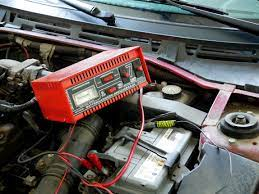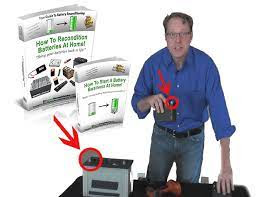Today, batteries are a part of everyday life, and our cars are the best example of this. Let's face it: if your automobile has a battery, your car has a battery. However, if these batteries are pricey, you have other options.
Repairing the automobile battery is one such option, and it's lot simpler than you may imagine. In fact, with a few simple tools and a little perseverance, anyone can fix a car battery at home.
The car battery is recharged repeatedly, which causes sulfate to build up over time on the positive plates. In the end, this sulfate buildup makes the battery less effective and causes it to last longer the next time. In order for the automobile battery to operate more effectively, sulfate is removed from the plates during recovery. This nearly completes the battery charge restoration.
The battery's plates cannot be repaired or replaced if they are damaged. In actuality, the recovery only cleans the battery and enables it to function much more effectively by removing the sulfates that have built up on it.
What are the advantages of car battery repair?
As you might expect, recycling a car battery has several benefits over throwing it away, some of which include the following:
Many dollars will be saved by you. Car batteries typically cost between 70 and 200 dollars, but you can replace one for roughly 25 percent of that amount.
Your battery's lifespan can be increased. Car batteries typically have a lifespan of five years, but they can be repaired to increase that lifespan by one to two years, allowing you to put off purchasing a new battery for a little while longer.
It's a great business idea. Not everyone knows how to repair a car battery, so you can earn money by offering this service to others.
As a result, fewer batteries are used, which lowers the annual amount of hazardous chemicals dumped in landfills.
These benefits are all excellent ones for fixing a car battery, while some may be more significant for some people than others.
How can I know whether the battery in your car needs to be fixed?
If you think your car's battery is sort of dying, you can fix it. If the voltage is between 10V and 12.6V, which you may establish by measuring it, a good repair might be necessary.
Although there are alternative methods, measuring the voltage is actually the simplest approach to tell if the battery needs to be repaired. It is advised to fix the battery if it is unclean and full of plaque before it deteriorates and discharges at home.
The first thing you need to do is to carefully inspect your car battery. If there are dents, cracks or broken clamps, the battery should not be repaired, just buy another one.
Before starting the restoration process, it is necessary to prepare the following elements:
Apron
Chemically resistant gloves
Safety glasses or face mask
Distilled water
Baking soda
Toothbrush or paint brush
Steel wool
Voltmeter
Flat Head Screwdriver
Plastic bucket
Funnel
Epsom salt
Load Tester (optional)
Here is a step-by-step description of how to restore a car battery at home:
1. Clean the battery.
Hank, Hank, Hank 2:1, Hank, Hank. You will see a chemical reaction, but this is normal. Then use steel wool, a toothbrush, or battery terminal cleaner to clean both the positive and negative terminals. Completely clean, then wipe and dry the terminals.
2. Check the battery readings.
Use a voltmeter to check the battery voltage. Make sure that the red cable goes to the positive terminal and the black cable goes to the negative terminal. 12,6, 12, 6. Die 10, die 12,6, die 12. If the voltage is below 10 Volts, it means that an element has discharged in it and probably needs to be replaced.
3. Discharge the battery.
Protective clothing is REQUIRED for this step! Slowly remove the top caps from the battery with a screwdriver. Flip the caps aside and pour the electrolyte solution from the battery cavity into a large bucket. Make sure you are very careful and pour away from yourself. When you're done, pour half a pound of baking soda into the electrolyte solution to neutralize the acid and dispose of it.
4. Clean the batteries.
^ 2:1, 1:1. Using a funnel, pour the mixture into each of the battery cells. Make sure that each element is filled, then replace the plastic battery caps until they are securely fastened. Gently shake the battery for two to three minutes. Then remove the lids again and pour the baking soda solution into the trash bucket.
5. Replace the electrolytes.
You will start by warming four cups of distilled water, then pour it into a clean bucket. Die, die, die, die, die, die, die, die, die, die, die, die. Then use a funnel to fill the batteries with this solution and replace the caps. Shake the battery slightly and you're done.
6. Charge the battery.
This step should be performed using low power. Remove the caps and place the charger away from the battery, then reconnect the red and black wires to the positive and negative terminals, respectively. ^ 12 ^ / 2 = 36. Hank, Hank 12,43 Hank 12,6 Hank, Hank.
You can test in one of two ways: using a load tester or using your car. ^ "Hank" (Hank). Then turn on the headlights, you can also turn on the radio. Leave the car in this position for a few minutes without turning it on completely, and check the battery with a voltmeter. ^ 9,6.
If you have an electric or hybrid car, the steps are a little different and a little more complicated. Die 200 000, die 200, die 200, die 200. Hank-Hank, Hank, Hank 3000 Hank.
^ 700^, das. However, if you are going to buy electric cars, you can study companies that rent batteries to their customers rather than sell them, and in this case they will take care of it for you.
Precautions that you need to take into account
Precautions that you need to take into account - How to repair a car battery at home?
You should keep in mind that you will be working with battery acid, so you should take precautions to keep yourself safe. This includes wearing protective clothing or at least a tight apron, a protective face mask or a pair of safety glasses and chemical resistant gloves. Even if you are very careful while working, there is always a chance of getting a little acid on yourself, which is why it is so important to have protective gear.
In addition, you should always strictly follow the instructions to reduce the likelihood of any kind of accident. And finally, prepare a 2:1 solution of baking soda and water to use in case you accidentally spill something on your face or hands.
^ (Faxen)
Q: When should I repair the car battery?
Answer: The good news is that you don't have to wait for your car's battery to fully discharge. Even if the battery is only one or two years old, you can extend its service life if you continue to repair it.
Q: How often should you repair the car battery?
Answer: This question is difficult to answer because it varies depending on the battery and how often you use the car. People who drive a car every day will repair the battery more often than those who drive only occasionally.
Question: What causes the sudden discharge of the car battery?
Answer: Car batteries are usually discharged if you left the headlights on for a long time, if there is too much corrosion in the battery, if you have a failure in the charging system, or even if the car has been parked for too long and left alone.
Q: How long do the refurbished batteries last?
Answer: It largely depends on the condition and brand of the battery. While some people find that their refurbished battery lasts for weeks or months, most people get one to two years off of it. But if you don't, don't worry, because maybe the battery was in worse condition than you thought at first.
Q: How long does it take to restore the car battery?
Answer: The process itself does not take so much time, but the charging period means that it will take at least 24 to 36 hours, sometimes longer. Charging the battery is what delays the process.
Question: What happens if the battery is overcharged?
Answer: It is not recommended to overcharge the battery simply because it may suddenly run out while driving. This is too much overload for the battery itself. And since you never know when or where the battery will run out, your best option is not to recharge it in the first place.
Question: At what voltage does the car battery discharge?
Zimmer: 10,5 Zimmer, Zimmer, Zimmer. Hank, Hank 12,4 Hank, Hank, Hank. 12,4 15%; 12,7 13,2 100%.
Q: How do you restore a battery that doesn't hold a charge?
Answer: If the voltmeter shows a voltage below 10.5V, you can restart it, but there is even more chance that you will just need a new battery.
Question: Is it possible to charge a fully discharged battery?
Answer: If the ignition of your car does not even turn on, it may mean that the battery in your car has run out. You can start the battery to make it work again, but at some point nothing will work, and you will either have to repair it or buy a brand new battery.
Conclusions:
The auto battery recovery method is a fantastic way to save money and increase the lifespan of your battery, despite the fact that many people are unaware of it. The method itself differs slightly based on the type of battery being recovered, but interestingly, other sorts of batteries, such as those for mobile phones, laptops, golf carts, and many others, can also be restored. The steps for restoring the battery could appear difficult at first, but when you do them only once, they become much simpler.
The fact that a car battery may be repaired and not thrown away into a landfill, however, may be its biggest benefit. Because of how beneficial it is to the environment, restoration goes hand in hand with reuse and recycling. Car battery repair is a fantastic choice if you're concerned about leaving a smaller carbon footprint and being more considerate of Mother Earth. It is a financially and practically logical thing to do because it costs far less than you might anticipate.


Comments
Post a Comment